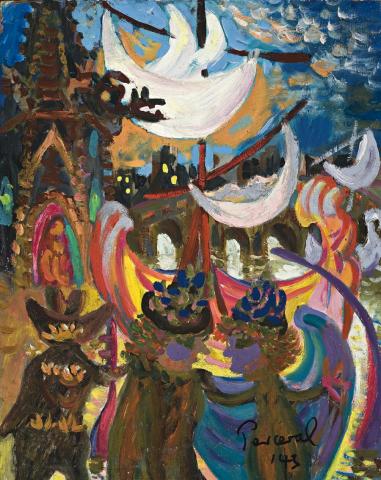BOATS AND MOONS, 1943
John Perceval
oil on composition board
54.0 x 42.5 cm
signed and dated lower right: Perceval / '43
Acland Street Gallery, Melbourne, 1987
Irving Fine Art, Sydney (label attached verso)
Private collection, Sydney
Mr M.J. Dougherty
Martin Browne Fine Art, Sydney (label attached verso)
Private collection, Sydney
John Perceval, Albert Hall, Australian National University, Canberra, 1966, cat. 13 (label attached verso)
John Perceval, A Retrospective Exhibition of Paintings 1935–1972, Heide Park and Art Gallery, Melbourne, 1984, cat. 12
Of Dark and Light, The Art of John Perceval, retrospective exhibition, National Gallery of Victoria, Melbourne, 1992 (label attached verso)
Reid, B., Of Dark and Light, The Art of John Perceval, National Gallery of Victoria, Melbourne, 1992, p. 16
Allen, T., John Perceval, Melbourne University Press, Melbourne, 1992, pp. 41–42, 148 (illus.) Melbourne, 1992, pp. 41–42, 148 (illus.)
John Perceval's art is strikingly individual, seen equally in those night paintings of the forties as in his later Gaffney's Creek and Williamstown series. This is apparent in Boats and Moons 1943-44, especially in its pulsating rhythms and idiosyncratic images. The youngest of those pioneering Melbourne artists of the 1940s - Albert Tucker, Sidney Nolan, Arthur Boyd, Danila Vassilieff and others - the passionate involvement of Perceval and his contemporaries in the urban life around them completely changed the direction of Australian art. It was wartime. Perceval, Boyd and Nolan were uncomfortably in uniform; and the streets of Melbourne were packed with soldiers, especially American. John Reed evoked the mood:
At night, and particularly around Flinders Street station, the scene was something to remember, with thousands of people, mostly in uniform, and with a fair sprinkling of the inevitable camp-followers, all aimlessly milling around, with nothing much to do and only too ready to be entertained with any drama or comedy which might eventuate.1
Reed saw Perceval 'having the time of his life', noting that he was 'drawn to people where a certain atmosphere exists', to 'the tension of a crowd, or the particular air of an hotel or bar.'2 It was this feeling of integration that Reed rightly saw as being a distinguishing feature of Perceval's art. Moreover, he took the lead in his painted experiences of the city at night, preceding those of Tucker's Images of Modern Evil. A major work, Negroes at Night, 1944, is in the collection of the National Gallery of Australia, Canberra. In another significant work, Flinders Street at Night, 1943-44, dancers and trumpet players unite in erotic frenzy.
Boats and Moons is a major work from this series, closely related to Railway by Night, 1943, in which Perceval introduced the State Theatre as the architectural background. As in Railway by Night, 1943, with its crescent moon-come-sail come boat, the scene in Boats and Moons is nearby Flinders Street station. The gothic tower and spire complete with grotesque gargoyle refer to St Paul's Cathedral and the arched bridge to Princes Bridge across the Yarra River. The rest is pure fantasy - the repeated shapes of the descending crescent moon transformed into boats, sails, and a gondola of grand proportions and colour. The touch of Venice and its carnivale culminates in the costumed foreground figures, masked, yet revealing in their revels. Perceval's early attachment to scenes bubbling with life and bobbing boats was later to be richly realised in the fullness of maritime busyness in his great Williamstown series of paintings.
1. Reed, J., 'John Perceval', Art and Australia, Sydney, vol. 5, no.1, June 1967, pp. 354 & 358
2. Ibid., p. 358
DAVID THOMAS
